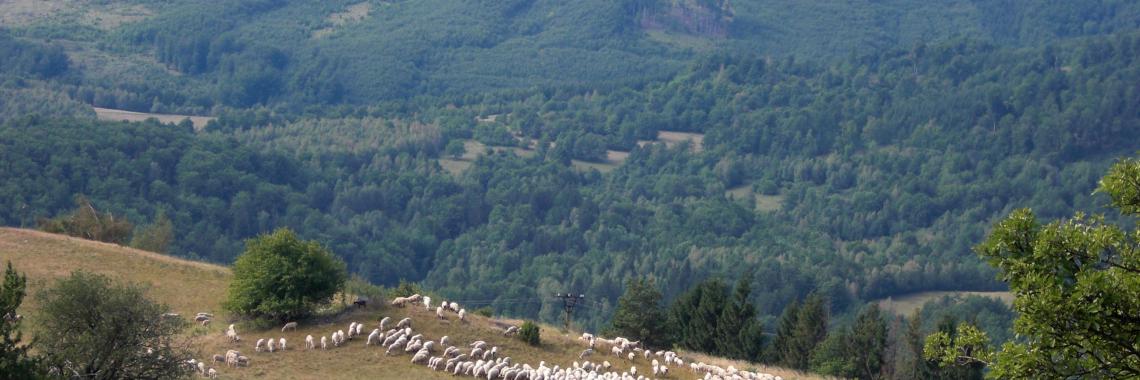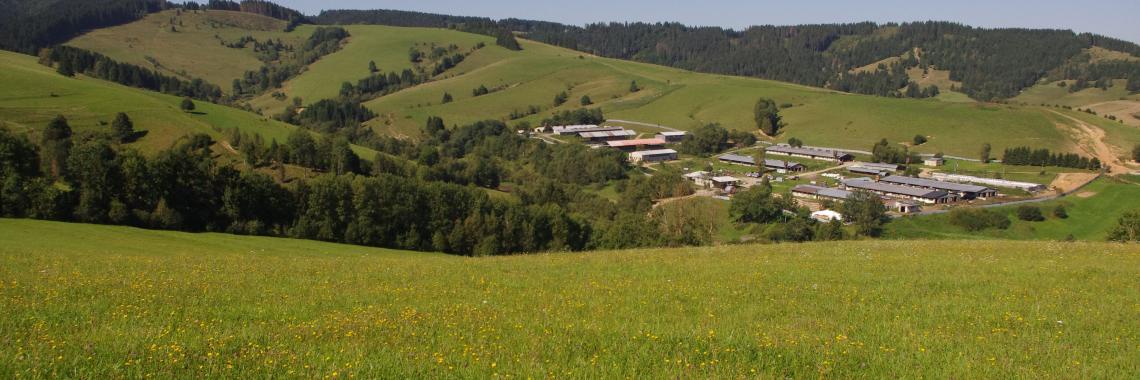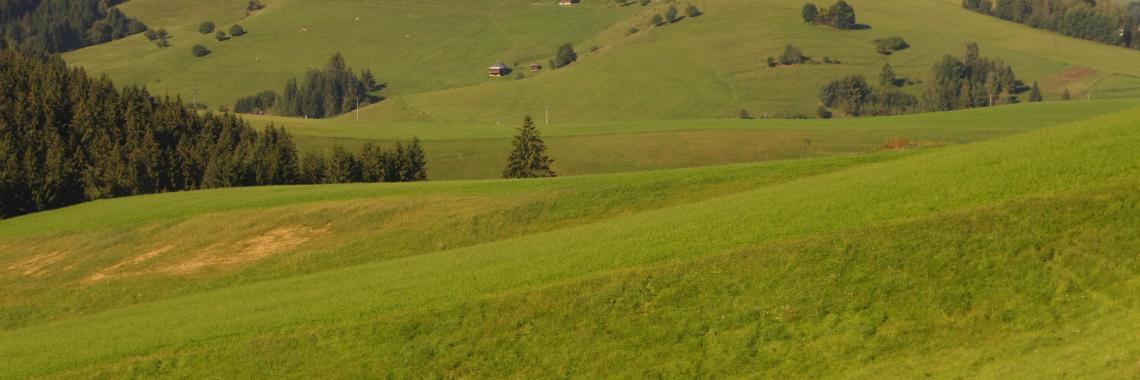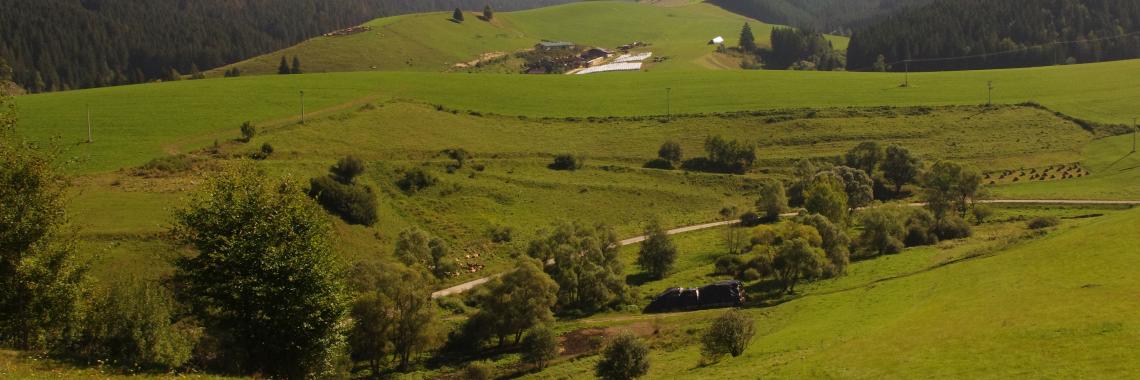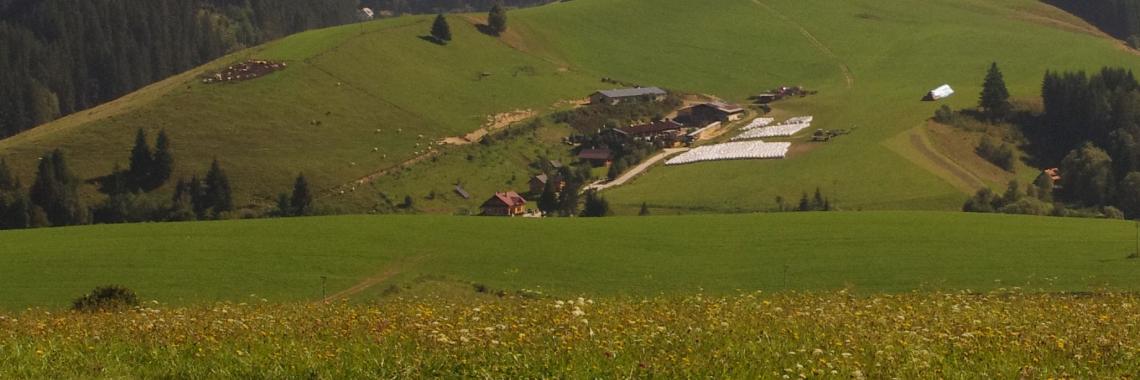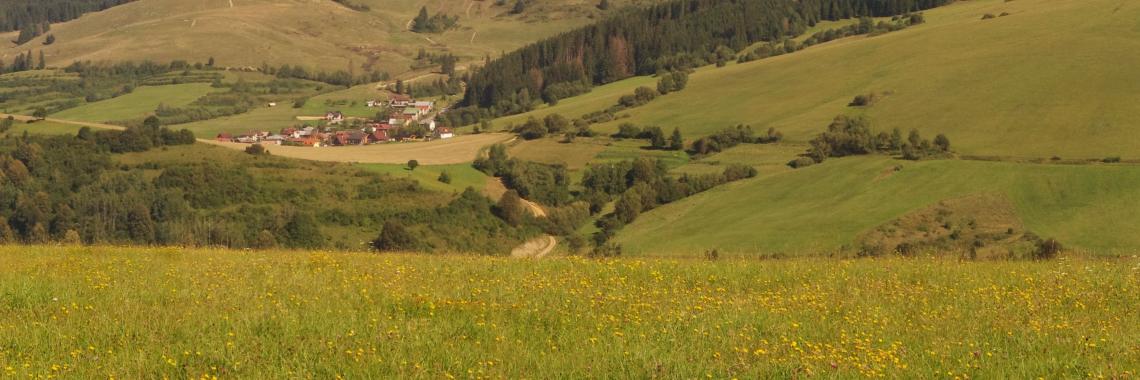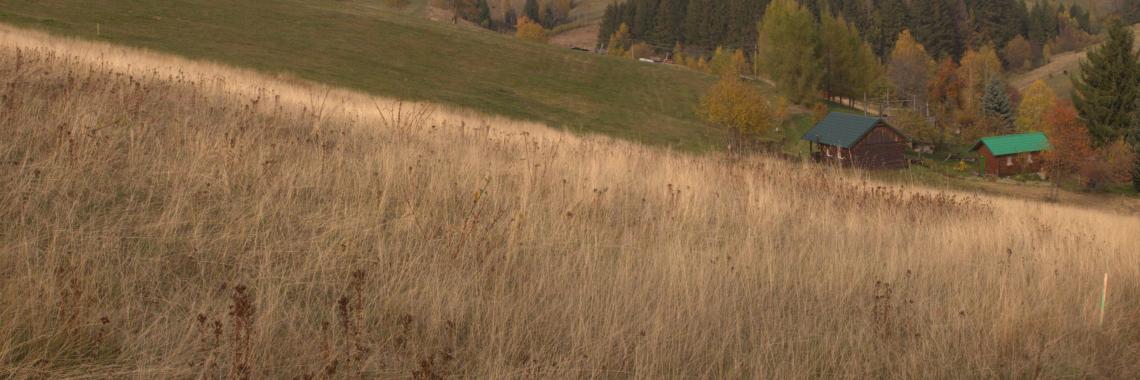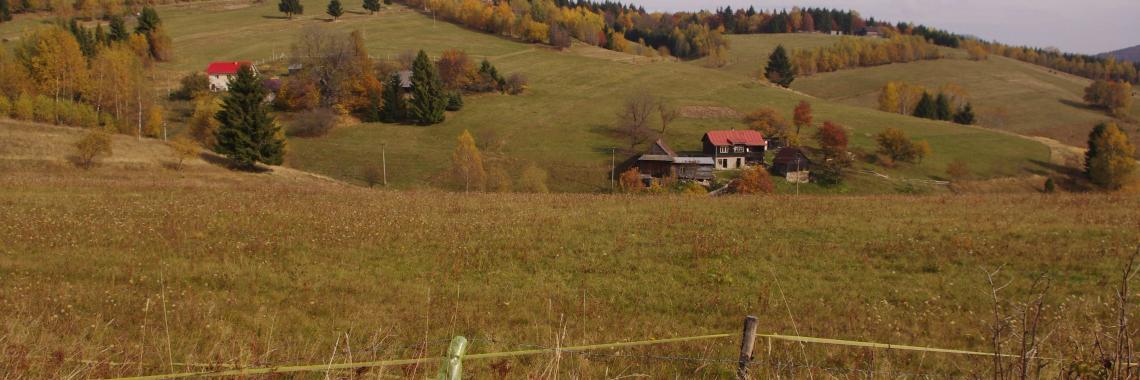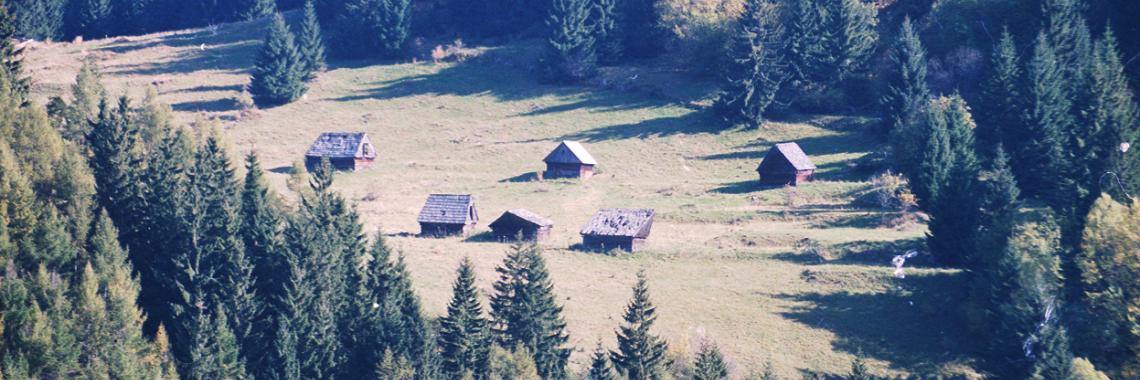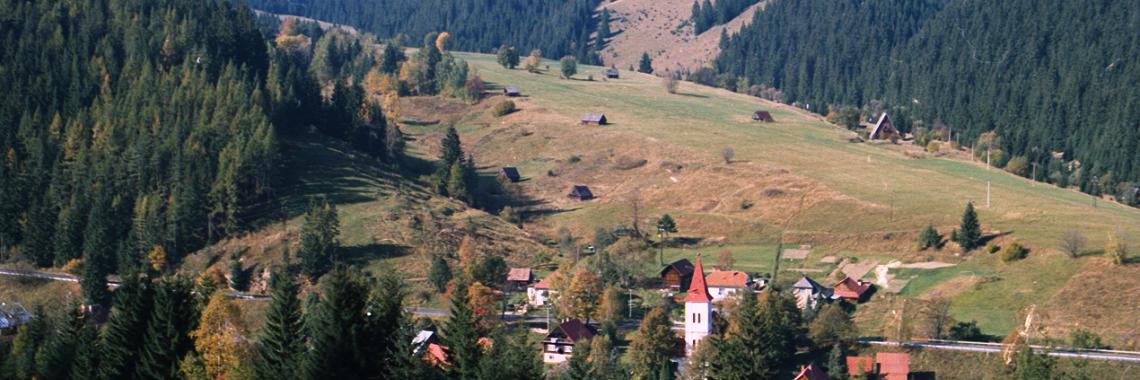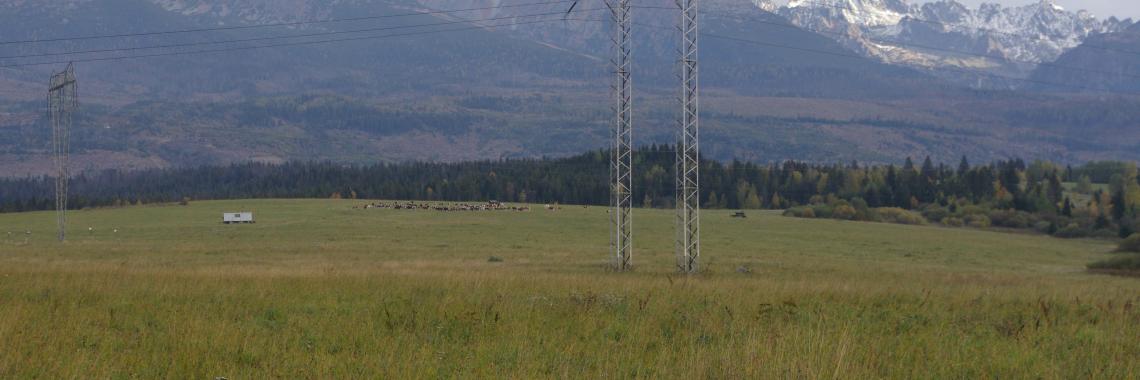Pasture in Slovakia
06.06.2018, by Bénédicte Gaillard
Research: Martina Slámová, Jana Špulerová, Marta Dobrovodská, Dagmar Štefunková; upload: Bénédicte Gaillard.
A very important argument for creating a culinary tourism related to the milk products making in Slovakia is truly a long tradition which extends to the prehistoric times. It is indirectly proven by the archaeological findings of sheep bones and ceramics for straining coagulated milk discovered in the Domica cave which date back to 2,000 years BC (Matlovičová, Pompura, 2013).
Sheep breeding is documented until the Neolithic period in the region of the High Tatras. The presence of sheep in the earlier Stone Age was documented in Matejovce near the town of Poprad, in an altitude of 650 m. n. m. In Burbrich, near the village of Veľká Lomnica, there were found prawns of clay, which prove that more than 2000 years ago local people were able to process wool (or flax). There were also some clay cloths showing sheep. Sheep sculptures were the most numerous, as well as sculptures of cows, goats, pigs, deer, etc. were found. (Zámečníková, 2008).
From the sheepherding point the Wallachian colonisation (the 14th- 17th / 18th centuries) brought a new mountain pastoral so-called alpine way of sheep breeding. During the reign of Maria Terezia and Jozef II, there was a significant modernisation which contributed to the increase of wool, meat and milk production. Historical geographical regions of Orava, Turiec, Liptov, Zvolen, Spiš, Gemer and Šariš are considered to be traditional areas of the production of bryndza (Matlovičová, Pompura, 2013).
48.5924637, 15.2107943
BARANČOK, P. , BARANČOKOVÁ, M. (2012): Research of Landscape Diversity of Kysuce Region with Emphasis on the Historical Structure of the Agricultural Landscape. Životné prostredie, 46, 1, 11 – 15. http://147.213.211.222/sites/default/files/2012_1_011_015_barancok.pdf
BARÁNKOVÁ, Z., DOBROVODSKÁ, M., ŠTEFUNKOVÁ, D., BABICOVÁ, D., MOYZEOVÁ, M., PETROVIČ, F. (2011): Participation of local people on identifying the landscape values and future development in historical agricultural landscapes. In Ekológia (Bratislava), 30 (2), 216-228.
CEBECAUEROVÁ M., CEBECAUER T. (2008): Spatio-temporal trends of landscape development in southwest part of Slovakia: Analysis of major landscape change types. Ekológia (Bratislava), 27, 2, 212–228.
CULINARY TOUR “BAČOVA CESTA (route through mountains areas visiting chalets and restaurants offering traditional Slovak sheep milk products): http://www.bacovacesta.sk/index.htm
DOBOŠOVÁ, A. (2002): Hole Národného parku Malá Fatra, aká je budúcnosť (pohl'ad botanika)?, Oecologia Montana, 11, 35- 37.
DOOR (2013): Databáza poľnohospodárskych produktov a potravín EU, Európska komisia, Poľnohospodárstvo arozvoj vidieka, E-služba na serveri EUROPA, March 4, 2013, http://ec.europa.eu/agriculture/quality/door/list.html;jsessionid=pL0hLqqLXhNmFQyFl1b24mY3t9dJQPflg3xbL2YphGT4k6zdWn34!-370879141.
HALADA, L., EVANS, D., ROMA, C., PETERSEN, J.E. (2011): Which habitats of European importance depend on agricultural practices? Biodiversity and Conservation, 20, 2365–2378. DOI 10.1007/s10531-011-9989-z
HREŠKO J., KANÁSOVÁ D., PETROVIČ F. (2010): Landscape archetypes as the elements of Slovak historical landscape structure. Ekológia (Bratislava), 29 (2), 158–173.
JANČURA, P., SLÁMOVÁ, M. (2014): Importance of the Mining Landscape as a Cultural Heritage. Životné prostredie, 48, 2, 115 – 117 https://stary.tuzvo.sk/files/FEE/katedry_fee/kptk/10_jancura.pdf
KOPECKÁ, M., VATSEVA, R., FERANEC, J., OŤAHEĽ, J., STOIMENOV, A., NOVÁČEK, J., DIMITROV, V. (2012): Selected changes of arable land in Slovakia and Bulgaria during the period 1990-2006, Moravian Geographical Reports, 20 (1), 43-54.
Landscape Atlas of the Slovak Republic: Layer: Tradičná lúčno-pasienková krajina (ID: 13) (in EN traditional meadow-pastoral landscape) http://nipi.sazp.sk/ArcGIS/rest/services/atlassr/atlassr_05_rest/MapServer/13
MATLOVIČOVÁ K., POMPURA, M. (2013): The Culinary Tourism in Slovakia Case Study of the Traditional Local Sheep's Milk Products in the regions of Orava and Liptov. GeoJournal of Tourism and Geosites, Oradea - Gdańsk, Year VI, 2 (12), 129-144.
MIKLÓS, L., HRNČIAROVÁ, T. [eds.] 2002. The Landscape Atlas of the Slovak Republic. Bratislava, MŽP SR and Banská Bystrica, SAŽP, 344 pp.
PÁSTOR M., SLÁMOVÁ M., BENČAŤ T. (2017): The distribution and biocultural value assessment of sweet chestnut (Castanea sativa Mill.) in the cadastral districts of Stredné Plachtince and Horné Plachtince (Slovakia). Ekológia (Bratislava), 36 (2), 130–145.
ŠEBO, D., KOPECKÁ M., (2014): Abandonment of agricultural landscape after 1989: a case study from the Považie Region, Slovakia. Geographical Journal, 66, 4, 323-339.
SLÁMOVÁ M., JANČURA P., DANIŠ D. (2013): Methods of historical landscape structures identification and implementation into landscape studies. Ekológia (Bratislava), 32, 3, 267–276.
SLÁVKOVSKÝ, P. (1989): Roľník a jeho práca: tradície poľnohospodárskej výroby slovenského ľudu. Bratislava: SAV, pp. 47.
ŠPULEROVÁ, J., DOBROVODSKÁ, M., IZAKOVIČOVÁ, Z., KENDERESSY, P., PETROVIČ, F., ŠTEFUNKOVÁ, D. (2013): Developing strategy for the protection of traditional agricultural landscapes based on a complex landscape-ecological evaluation (the case study of mountain landscape in Slovakia). Moravian Geographical Reports, 21 (4), 15–26, DOI: 10.2478/mgr-2013-0017
VALKOVCOVÁ, Z., RUŽIČKOVÁ, H. (2007): Vplyv využívania krajiny v časovom horizonte 50 rokov na súčasné druhové zloženie lúk horného Liptova. In: Krajčovič V. (ed.), GRASSLAND ECOLOGY VII. Book of Proceedings from International scientific conference on the occasion of the 45th anniversary of the establishment of the Grassland and Mountain Agriculture Research Institute and a jubilee of prof. Ing. Vladimír Krajčovič. Banská Bystrica, Slovakia, p. 220–223.
ZÁMEČNÍKOVÁ, H. (2008): Pastoralism – Pastierstvo. Žilina: Institute of the High Mountain Biology University of Žilina. ISBN 978-80-88923-16-9.
Grasslands communities occupy approximately 33.2% of agricultural land in Slovakia - of which 10.5% are meadows and 22% are pastures. These numbers vary from year to year (Hegedüšová et al.).
Pastures occur also in high mountains at higher altitudes (circa from 900-1500 m ASL). Conservation of higher located pastures is important in terms of preserving the historical landscape and its species and biodiversity. The most valuable is tundra with small brushes, endemic and relict species rich in Sesleria varia, Sesleria tatrae, Festuca versicolor, Poa alpina and others (these species are known from Kriváňska Malá Fatra Mts.) (Dobošová, 2002). Abandonment of grazing leads to the invasion of pastures by shrubs/trees and a change to a shrub- or woodland habitat type or to simplification of their structure associated with a decrease of species richness and the loss of sensitive species (especially weak competitors) (Halada et al., 2011).
Pastures occur opened as well as a part of land cover mosaic, can be used extensively as well as intensively and their existence does not depend on natural conditions. However, usually are located in less fertile soils of higher situated localities on less fertile soils in lowlands and intermountain basins (like gley-clay waterlogged soils on river terraces or slope sediments).
Existence of pastures is not linked with specific soil types, climate, slope or aspect. However, pastures usually occur in less fertile, sometimes waterlogged soils and they are typical for localities of higher altitude - more than 450 m ASL where are not suitable conditions for cultivation of cultural plants.
The collectivisation and modernisation of agricultural production induced extensive changes especially during the first period, the mosaic of small plots of arable land and pastures cultivated by individual farmers was replaced by large plots of arable land cultivated by co-operative and state farms and the extent of pastures considerably decreased. Only in the last period (1992–2003), the reverse processes appeared, the extent of arable land decreased and area of pastures increased. This trend is the result of political and economic transformations that started in 1989 and actual influence of the European agricultural policy – the trend of intensive agricultural cultivation only on the most productive areas (Cebecauerová, Cebecauer, 2008). Characteristic landscape appearance of mountainous agricultural landscapes is mostly endangered by the destruction of architecture and natural successive processes on the traditional pastures (Slámová et al., 2013).
The change of mountain meadows on pastures was a very frequent phenomenon at the time of collectivization of agricultural production in our country. Many species-rich meadows, formerly grazed only in certain cycles, due to fertilization have become intensive pastures. Slovakia lost not only meadows, but also about the unrepeatable landscape character. For example, around the village of Východná there were 700 hay-lofts, above Liptovská Teplička it was 550, which were almost all dismantled or, due to non-maintenance, underwent destruction (Valkovcová & Ružičková 2007).
Shepherding is always related to cheese making or milk production and processing of milk product. Special cheese is “bryndza” tha is a part of the national meal – bryndza with dumplings and fritted bacon. Common are expressions, geleta or urda with meaning of a special cup for žinčica (a milk product from sheep milk) coming from foreign (Matlovičová, Pompura, 2013).
Nowadays, Slovak products made of sheep ́s milk represent products of high quality with special characteristics. They are connected to a particular territory or place and their name is connected to their historical trademark (Matlovičová, Pompura, 2013). As authors cited (DOOR, 2013): “On the basis of these and other attributes, the Slovak Republic has actually three protected geographical indications for sheep milk products registered in DOOR: EU database of agricultural products and foods - Slovenská bryndza, Slovenská parenica, Slovenský oštiepok and two agricultural products and foods registered in TSG – Traditional Speciality Guaranteed - Ovčí salašnícky údený syr, Ovčí hrudkový syr – salašnícky. Slovenská bryndza known as “white gold” is defined as “a natural, white, mature, spreadable cheese in granular form,manufactured according to the traditional method, by milling a lump of matured sheep's cheese or by milling a mixture of lump sheep's cheese and lump cow's cheese. The percentage of lump sheep's cheese is greater than 50 %. It has a delicate odour and taste and has a pleasantly sour sheep's cheese taste that is slightly spicy and salty.”
The current dominant landscape structure encompasses grasslands differentiated by land use activity including intensively or extensively utilized meadows or pastures, some of which are tessellated or have lengthwise mounds (Špulerová et al., 2013).
The species composition is affected by environmental conditions and management intensity with the highest abundance recorded for semi-natural species, rich mesophilous meadows connected to humid mountain areas. However, pastures affected by collectivisation are characterized by low species abundance (Špulerová et al., 2013).
From the time of the Walachian colonization Alpine area used to offer suitable conditions for the pasture lands establishment and widening. Alpine grassy uplands are not agriculturally utilized on the present. Activities of the repeated dwarf pine and forest crop planting in the areas of their previous elimination have been connected with the alpine pasture lands leaving. Processes of felling, burning, pasturage and local planting had the important influence on the development of the further dynamic processes as are avalanches and debris flows. Pasturage had influenced spatial expansion of the avalanche areas in almost all of the Slovak mountains with grassy upland and cliff grassy upland relief. Typical example of the mentioned utilization and the further revitalization of the alpine landscape are the areas of Krížna in the Veľká Fatra Mts as well as the areas of Jalovecká dolina valley in the Západné Tatry and Belianske Tatry Mts in the valleys of Zadné and Predné Meďodoly Mts. (Hreško et al., 2010).
Preserved folk traditions and folk art like Slovak shepherds’long pipes (fujara) or traditional agriculture with sheep and cows breeding and cheese and milk production are understood by public to be a cultural heritage belonging to a particular landscape (Baránková et al., 2011).
On the on that basis of our results in the case study of the Stredné and Horné Plachtince cadastral district, we can conclude that category of “agricultural areas – Pastures – Pastures” was the most valuable CLC category here. Besides, sweet chestnut faces unfavourable living conditions in Slovakia. It interferes with traditionally used pastures and meadows, as we presented in the results. The chestnut occurrence coincides with the HNV farmlands and also with the habitats of European importance. Moreover, taking a lack of available data into consideration, we have confirmed the presence of chestnuts in the vicinity of old stables representing the cultural heritage occurring on old pastures (Pástor et al., 2017).
Historically interesting is that even after the establishment of capitalism, the villagers still cared for the meadows and forests in the confines, as evidenced by the Law on the co-ownership of urban forests and pastures from 1872 (Slávkovský, 1989). Meadows and pastures were maintained and managed under the municipal property of residents.
Pastures are well know by public and usually, when we associate them with landscape character we can imagine mountains wooden chalets, hay-lofts, green pastures, and sheep or cows. Goats are not so typical and they are usually mixed with other cattle in Slovakia. Shepherds use to have special whistles – small ones or bigger called fujara – this musical instrument is strongly related to shepherding as well as shepherd´s pipes (gajdy). Shepherds’ clothing also had unique features (belts, bags, axes…) and their daily friends are dogs helping them managing herds.
There exist public initiatives like “Bačova cesta” - a route through mountains areas for tourist aiming to visit chalets and restaurants offering traditional Slovak sheep milk products: http://www.bacovacesta.sk/index.htm
Pastures (pasienky) are found in all regions in Slovakia, form lowlands, intra-mountain basins to uplands and highlands. Spreading of pastures to uplands and highlands (more than 400 m ASL) is linked with Wallachian and Ruthenian colonization phases between 14th – 17th (somewhere 18th) centuries. In some area it developed as a primary economic activity (Kysuce; Barančok, Barančoková, 2012) and in some areas it developed as a secondary economic activity (like for instance when mining finished shepherding is developed the cadastral district of Nižná Boca; Jančura, Slámová, 2008).
Slavs in the 4th and 5th century A.D. grazed the livestock on pastures near the settlements. During the feudalism pastures belonged to landlords. The urbar’s and pasture’s societies were created. Pastures are divided according to the method of use to individual and collective. From the 14th to the 17th century Wallachian colonization conditioned the formation of mountain sheepherding.
Example of the development of the traditional- meadows-pastoral landscape in the cadastral district of Nižná Boca : Nižná Boca was known for its gold mines in the Middle ages. Today, is visited by tourists who are looking for natural landscape and silence. From the point of view of the landscape classification of traditional land uses, area is classified as a meadow-pastoral landscape. Archaic hay-loft document Wallachian culture. Although meadow-pastoral landscape is visually dominant and represents the landscape character, it has evolved as a secondary source of livelihood, after the mining activity in the area finished (Jančura, Slámová, 2008).

